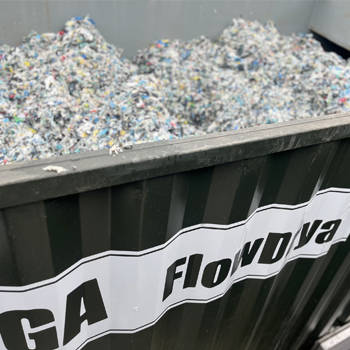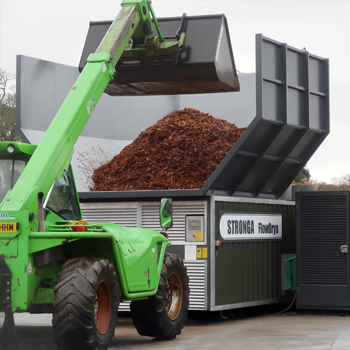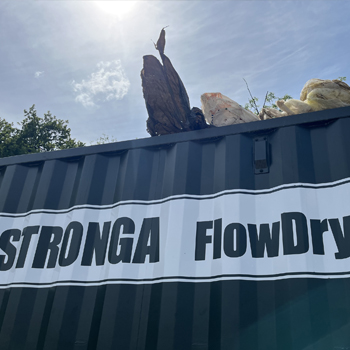What is Biochar?
Biochar is a solid material which is produced as a result of the thermal decomposition of various types of biomass - wood chips, organic waste, crop residue, manure and other. The heating process converts biomass from its original state into a solid, carbon-rich product within an oxygen-restricted environment, usually by the process of pyrolysis or carbonisation. Heat energy, syngas and bio-oils/fuels are also produced during the heating process and can be retained and reused for pre-drying purposes as part of a circular energy economy. The biochar output can be used for soil enrichment, carbon sequestration, renewable clean energy production, carbon credits/offsets and for offsetting greenhouse gas (GHG) emissions.
The purpose of this article is to discuss the importance of drying biomass (wood chip, crop residue and other) to a suitable moisture content prior to the pyrolysis reactor process. The graphic below demonstrates the important role of the FlowDrya in the biochar production cycle. Read on to learn more.

Who Can Produce Biochar?
There are a growing number of biochar production companies selling the resource for soil enriching purposes. However, biochar is made from organic, renewable biomass and most of this biomass would otherwise be wasted, left to decompose, or be burnt – all of which lead to increased GHG emissions. Farmers with suitable crop residue and organic waste who are looking to offset their GHG emissions might find biochar production a useful economic and environmental solution, in line with European government ‘green funding’ and net zero strategies.
We encourage customers to get in touch with Stronga to discuss the importance of drying biomass prior to the pyrolysis process - info@stronga.co.uk

Does Biochar Actually Improve Soil?
Biochar is produced as a result of recycling otherwise wasted biomass via the process of pyrolysis. The pyrolysis process creates residual energy which can be recovered and reutilised; and it also provides biochar - a resource which offers significant benefits for soil. Biochar is porous and has a high water retention capacity which allows for more effective nutrient retention and less leaching. Biochar also has the ability to hold carbon in the soil for decades, making it an excellent carbon sink, potentially removing billions of tonnes of atmospheric CO₂ every year.
Research shows that biochar creates ideal conditions for increased microorganism diversity in soil and positively influences fertility and nutrient content, allowing for higher quality crops with better yields. Read on to learn more.

The Significant Benefits of Biochar
Biochar is a natural soil improver, reduces soil acidity and liming requirements ✓
Biochar attracts and retains soil nutrients due to strong surface charge ✓
Biochar production reduces the need for non-organic, chemical fertilizers ✓
Biochar increases water filtration in soil (especially in compact soils) ✓
Biochar improves aeration in soil ✓
Biochar promotes microbial activity and soil bio-diversity ✓

Biochar allows for carbon sequestration and so contributes to a lower carbon society ✓
Biochar can retain and store carbon in soil for decades ✓
Biochar actively reduces N₂O and methane soil emissions ✓
Biochar can be used as an alternative or alongside compost but won’t decompose and release GHGs ✓
Biochar can hold up to triple its value of carbon in soil ✓
Biochar is renewable and sustainable ✓

Biochar has a porous nature – which is good for water retention in soils and nutrient storage ✓
Biochar improves poor infertile soils with arid climates and promotes crop yields ✓
Biochar can speed up compost decomposition process (Biochar increases microbial activity) ✓
Biochar improves soil ecosystems and aerobic structures which will improve plant and crop health ✓
Biochar supports soil structure and reduces erosion risks ✓
The benefits above depend on various factors including, climate, soil PH and more.

Can Biochar Contribute Towards Achieving Net Zero Targets?
Yes - biochar actively captures atmospheric carbon in soil! The agricultural industry is one of the biggest contributors to GHG emissions. Biochar utilises organic biomass that would otherwise release GHG emissions, whilst also removing atmospheric carbon and storing it in soil for many years (carbon sink). This soil encourages higher crop yields and food security in certain conditions, whilst also reducing emissions associated with importing clean soil from abroad. This makes biochar carbon-negative, contributing significantly towards net zero targets by reducing GHG emissions (methane and carbon).
Biochars help restore balance to the environment, even helping to create renewable energy through pyrolysis where the thermal decomposition of biomass creates two ‘by-products’:
1) Physical biochar output
2) Renewable, ‘clean’ energy via CHP (combined heat & power)
Bio-energy, bio-oils/fuels and syngas, can be used for other local operations on site and even power Stronga’s FlowDrya to dry the biomass before pyrolysis.

What are Biochar Carbon Credits & Offsets?
The carbon credit and offset scheme allows biochar producers to increase their revenue by selling the resource. They can also increase economic valorisation by adopting reduced carbon emission practises (decarbonisation) through biochar production and usage. This scheme allows biochar producers to benefit from production sites and corporations looking to outweigh some of their GHG emissions. Plus, through the formation of carbon markets, biochar producers are able to sell their carbon credits, creating a second stream of income. These carbon credits are awarded to companies who contribute towards reducing atmospheric carbon, limit emissions and incorporate sequestration practises.
The graph below shows that the voluntary carbon market has attracted significant interest in recent years. It has quadrupled in value and almost doubled in volume to reach USD 2 billion in 2021, with 166 million tonnes of carbon emissions avoided. The carbon credit market is expected to reach between USD 10 billion and USD 40 billion by 2030.

How Can Biochar Production Power Your Biomass Drying Equipment?
On top of producing carbon-negative soil improver, biochar production also generates clean residual heat energy through the carbonisation/pyrolysis process. Residual heat energy, rich syngas, bio-oils, gases and vinegars that are released during pyrolysis can be used via CHP and heat exchange to create the heat for the drying process. Residual energy created during the process can be used as part of a circular energy economy in the FlowDrya to dry biomass to a suitable moisture content. Dry biomass can then be fed into the pyrolysis reactor for significantly increased biochar output, cleaner operations and other benefits. This creates a closed-loop, circular, biochar production scheme.
Contact Stronga for more information about the residual heat drying process - info@stronga.co.uk

Are There Any Requirements for the Biomass?
In simple terms, the pyrolysis process and Stronga drying system can handle almost any form of biomass, so long as it is organic and sustainable. The pyrolysis reactor does however require dry biomass as it optimises biochar output and offers a more uniform process flow with much cleaner syngas output, amongst other benefits. Dry biomass produces cleaner energy with less ash and smoke emissions. Uniformity in biomass particle size may also provide equal and efficient thermal decomposition.

Why is it Important to use Dry Biomass for Biochar Production?
To ensure clean and efficient biochar production via pyrolysis, the biomass used needs to be dried to a suitably low moisture content. Depending on the design of the reactor, this is typically in the range 8 -15% moisture content. This graph below indicates the correlation between moisture and energy output of wood chips.

Research shows that dry and uniform biomass contributes positively to the pyrolysis process. By reducing the moisture content of the biomass, pyrolysis is more efficient, meaning less energy is lost in the process while a higher quality biochar output is produced. Biochar has many environmental benefits. Using wet biomass in the reactor would offset these, producing more smoke and ash.
Grant funding for biochar operations may be awarded to those actively adopting technologies for limiting GHG emissions. Biochar production is eligible providing the client dries the biochar before pyrolysis. Stronga’s biomass drying technology is able to dry biomass materials of all types, sizes and bulk densities. Contact us today to discuss your project.

What Makes FlowDrya the Leading Biomass Drying Solution?
As an alternative to Stronga’s continuous moving floor system, belt dryers have been adopted as a pre-drying treatment in the past. These have proven inefficient and generally expensive to own and operate. Stronga’s FlowDrya moving floor system is highly efficient, scalable, easily controllable and compact. Discover some of the benefits of using FlowDrya for repurposing residual heat from pyrolysis:
● Designed specifically for the material to be dried, FlowDrya is able to process all types of biomass from paper to fuel pellets.
● FlowDrya is fully insulated, ensuring excellent thermal efficiency with minimal heat loss.
● FlowDrya has intelligent, easy-to-operate HMI controls which allow the operator to adjust settings for optimum outcomes.
● The ‘DryStation™’ control panel offers live data logging which can be exported to CSV for record-keeping.
● The design of the FlowDrya is tailored specifically to the client’s biomass to be dried. Stronga carefully consider material properties, climate, region variability and much more to design an optimised drying system.

● FlowDrya’s unique PulseWave™ agitation system prevents clumping by continuously mixing the biomass material as it passes over the moving floor. The entire load receives uniform thermal contact and drying airflow – ensuring the final output is consistently dry.
● FlowDrya has a carefully-configured hydraulic moving floor design with airflow zoning to encourage excellent moisture evaporation and improve drying outcomes. These zones are configured specially for each project.
● The independent Heatex unit utilises residual thermal output energy – including the biofuels released during the pyrolysis process. This circular process works in line with the values of biochar – to limit atmospheric carbon and GHG emissions.
● FlowDrya is well suited to high-duty drying processes, capable of operating for 8,000(+) hours per annum.

If you have any further questions or to discuss how to optimise your biochar production using Stronga’s FlowDrya system, contact our sales team today - info@stronga.co.uk
We look forward to hearing from you.



Share this post